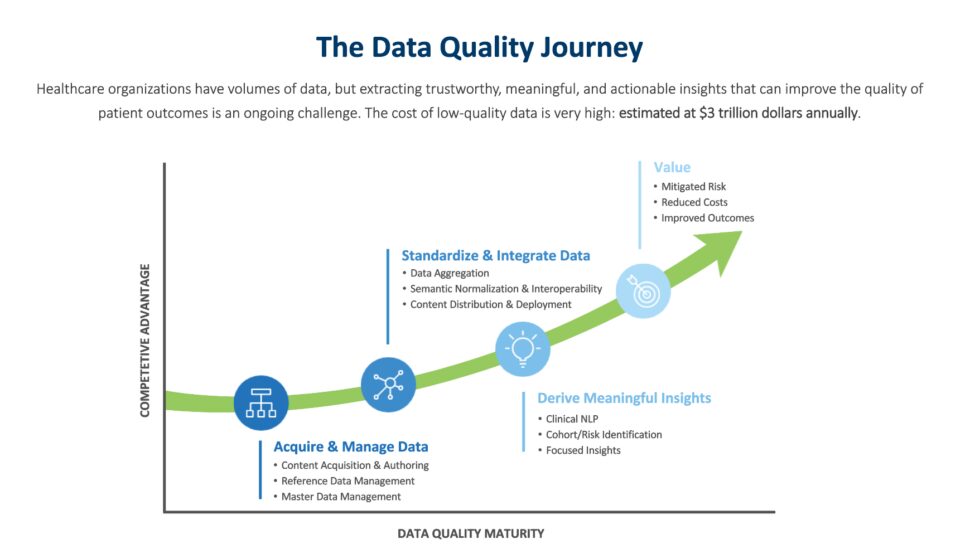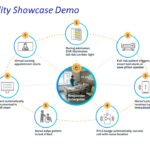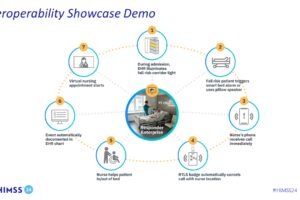Data quality is not a destination. It is a journey or perhaps a state of mind according to Clinical Architecture. There is risk in treating good data quality as a destination because what constitutes good quality today may not be sufficient for future needs. Data must be continuously improved, audited, and refined. Clinical Architecture has created a data quality journey map that helps its clients get started and continue pushing for improved data quality.
We spoke with Charlie Harp, CEO of Clinical Architecture via email about the data quality journey and what it’s implications are for healthcare organizations.
1. In the past you have talked about the cost of poor-quality data in healthcare. Is that all opportunity cost or are there real hard-dollar costs that we should be aware of?
The opportunity costs are real. Organizations don’t want their expensive human clinical resources engaged in repetitive, task-specific data cleansing projects, collecting data manually in spreadsheets. Using best practices, great software, and automation that accelerates your data collection, creation, enrichment, and normalization allows you to redirect those resources to initiatives worthy of their knowledge and training.
That being said, there are a few categories of hard-dollar returns when it comes to having an ecosystem that cultivates high-quality data. The first is the cost most people don’t talk about. This is the time and expense necessary to make your data usable. When faced with the prospect of a multi-year human resource intensive initiative to improve the quality of their data in a meaningful way, many organizations decide not to even attempt it. This is the mountain of data dismay. Once you get to better data quality, as long as you accept it as a lifestyle and not a one-time project, it is easier to stay there. We help our clients climb the mountain of data dismay by turning it into a molehill. With our software and approaches, the time and cost required to hit your first enterprise quality milestone is, measured in months and thousands, not years and millions.
Once you have achieved this initial milestone, which we sometimes refer to as “eating your vegetables,” you get to have dessert. Better data has limitless returns. The ability to accurately report your quality measures, the ability to see what’s happening across your enterprise, and streamlining how you share data with registries, public health, and analytics platforms have hard-dollar implications.

2. What are the significant stages or steps in the Data Quality Journey?
I mentioned this in my response to your first question. The first step is understanding how your data quality impacts your organization’s objectives. The second step is having the will to invest in the people, processes, and tools necessary to transform the data into the asset it could be. The third is making the ongoing curation of high-quality data a part of your organization’s culture. People with a beautiful lawn don’t just mow it once.
3. Are there ways to speed up the Data Quality Journey? Are there processes, best practices and/or technologies that can be brought to bear?
There are ways to get a head start. The first is working with resources, whether you hire them, partner with them or confer with them, that have experience and know the shortcuts and traps that you might encounter along the way. The second is to leverage software that reduces the burden on your valuable human resources as much as possible. The third is to use outsourcing services to augment your internal teams and get things done quickly. Success raises spirits and breeds success. Data quality is addictive, and once you see what’s possible with good data, it starts to snowball across your organization. My favorite part is when something that no one thought was possible happens: the look on people’s faces. It is awesome.
4. How can a healthcare leader measure their progress on the Journey and how would they know if they are going too slow or too fast?
There is no ‘too fast’. You go at the rate that your resources and organization can handle. I have never seen a situation where ‘too fast’ has been an issue. You can measure your progress on the Journey by knowing your priorities and objectives when you start. With our clients, we create a roadmap. Typically they have an initiative that is their primary driver for the quality improvement initiative. We define specific, measurable events within a reasonable timeline… and then try to beat expectations. Most organizations know where they are hurting and where things are broken. We make a list and a schedule and get to work. The progress on that list becomes the progress indicator for the Journey.
5. Where do healthcare organizations typically get stuck along the Journey?
There are two primary sticking points. Getting started is number one, as I mentioned, for the reason I mentioned. The other is typically related to organizational priorities. Sometimes after an initial success, there is a moment when the organization redirects to other initiatives. This can derail and possibly set things back. Sometimes this is unavoidable in a world of staffing shortages and global pandemics, but it can have consequences when it happens. The lawn keeps growing whether you have time to mow it or not. Our approach and solutions typically reduce the likelihood of the second sticking point because we try to minimize the ongoing effort as much as possible with intelligent automation and fit-for-purpose workflows.
6. If you were to look at the healthcare industry as a whole, where are we along the Data Quality Journey?
Most of us are still pulling on our boots, shouldering our packs, and shuddering as we look up the mountain. That being said, I am excited to see many organizations that have realized that the view is worth the climb. Some organizations are already part way there, realizing the benefits and looking for ways to take it even further.
7. Where can people go to find out more information about Clinical Architecture and the Data Quality Journey?
Come see us at HIMSS 2023, booth #2656 or check out www.ClinicalArchitecture.com
Clinical Architecture is a supporter of Healthcare Scene.













